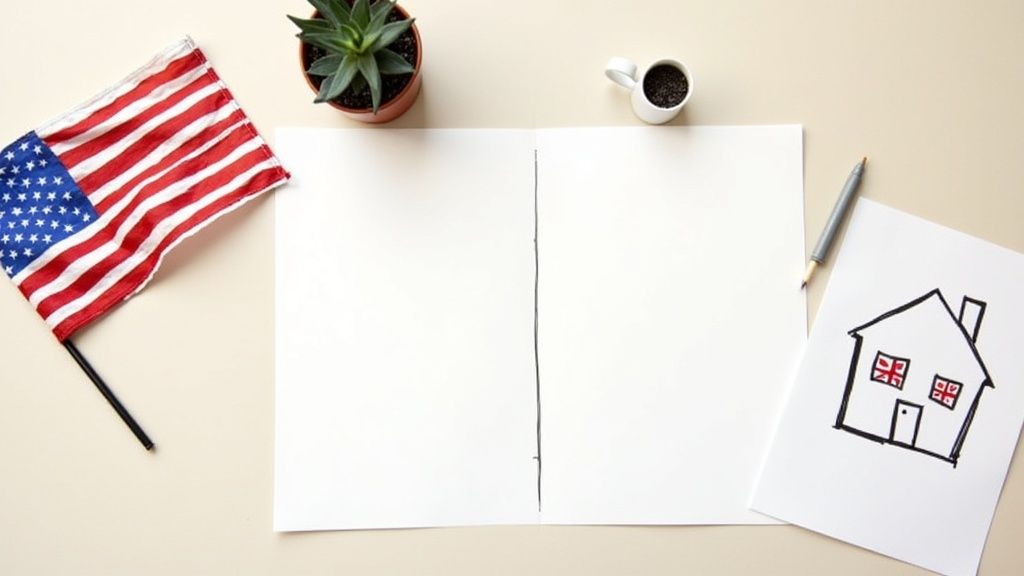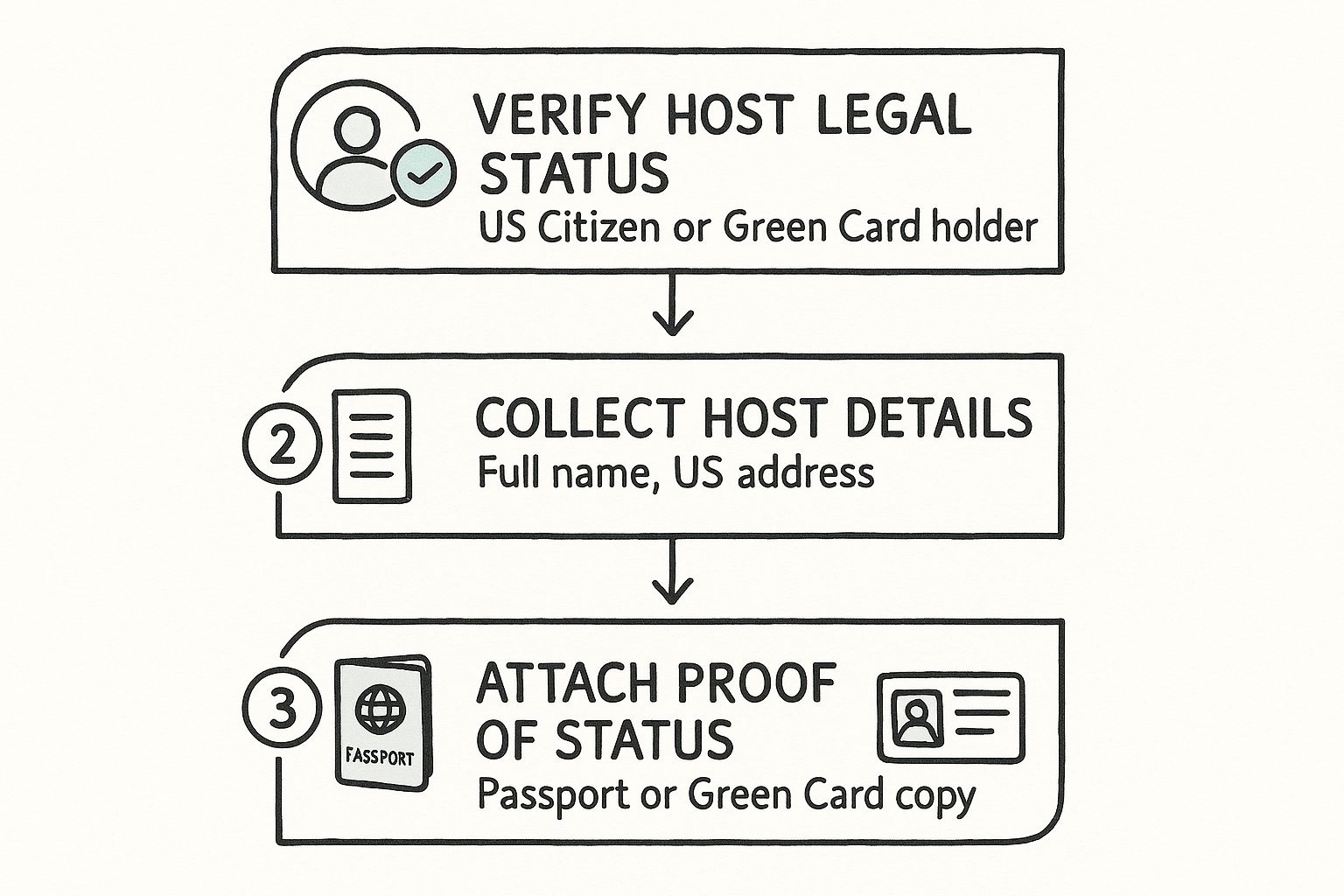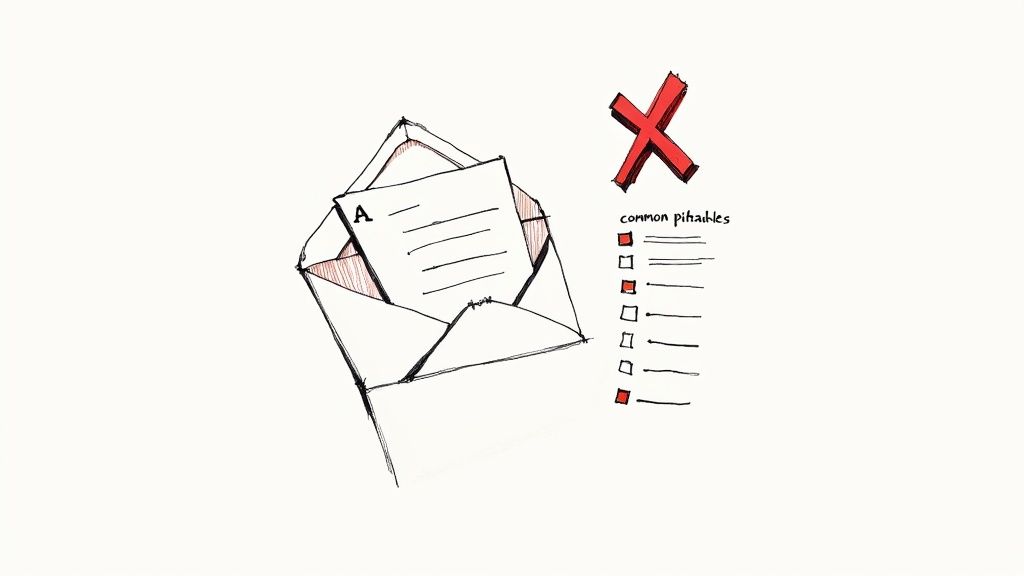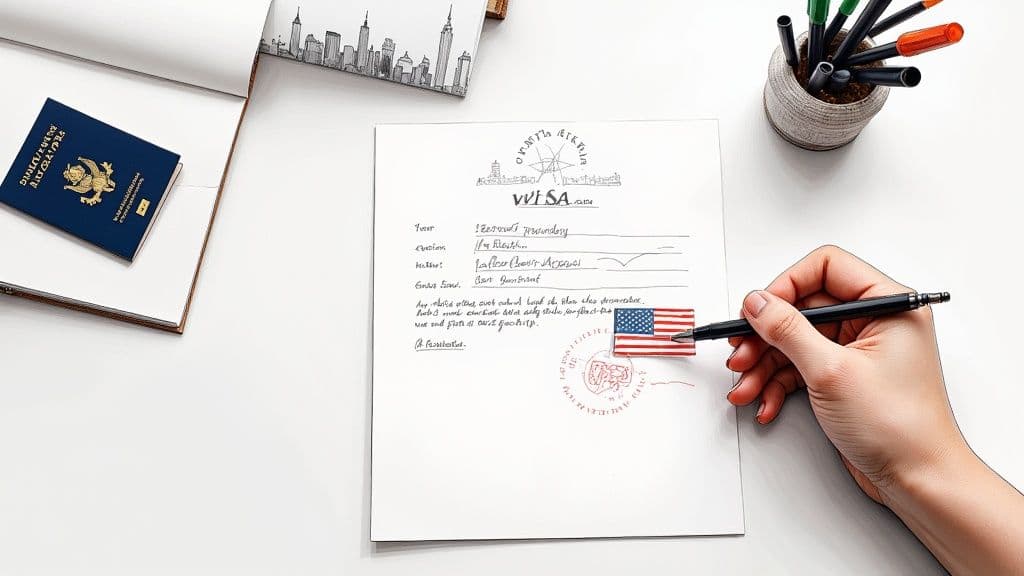A US visa letter of invitation sample is a great starting point, but knowing why you're writing it is the key to making it effective. While it's not an official requirement from the U.S. government, a well-crafted invitation letter can be incredibly powerful supporting evidence for a B-1 or B-2 visa application. Think of it as adding a significant layer of credibility to your story, especially if you're a B1/B2 applicant from a visa-required country.
Why an Invitation Letter Can Make or Break Your US Visa Application

This letter often acts as a personal reference for your entire trip. Its main job is to paint a clear, believable picture for the consular officer who has just a few minutes to review your case. For applicants coming from countries where visa scrutiny can be higher, such as Mexico, Colombia, or Brazil, this document can be especially persuasive.
A strong letter preemptively answers the big questions on the officer's mind:
Why are you traveling? The letter validates the reason for your visit. It’s not just a generic "tourism" claim; it’s a specific family wedding in Miami, a crucial business conference in New York, or a graduation in California. It adds context and legitimacy.
Who is your contact in the U.S.? It confirms you have a genuine connection—a U.S. citizen or lawful permanent resident who is vouching for you. This shows you have a reliable support system on the ground and aren't just arriving with no connections.
Will you be financially supported? The letter can clarify if your host is providing a place to stay or covering some expenses. This directly addresses the concern that a visitor might become a "public charge," a major reason for visa denials.
The All-Important "Non-Immigrant Intent"
At the end of the day, the consular officer's primary goal is to ensure you will leave the U.S. at the end of your authorized stay. The invitation letter is a fantastic tool for demonstrating this crucial non-immigrant intent.
By clearly stating the proposed start and end dates of the trip and outlining a specific plan, it shows your visit is temporary and well-defined, not an open-ended stay. This letter, written by your host in the U.S., helps tie all the pieces of your application together.
To get it right, the letter needs to include specific details. Here’s a quick breakdown of what makes an invitation letter truly effective.
Key Elements of an Effective Invitation Letter
This table summarizes the must-have information for a visa invitation letter that gets the job done.
Information Category | What to Include | Why It's Important |
|---|---|---|
The Host (Sponsor) | Full name, address, phone number, and proof of U.S. status (citizen or permanent resident). | Establishes the host's identity and legal standing in the U.S., adding credibility. |
The Applicant (Visitor) | Full name, date of birth, address, and passport number. | Clearly identifies the person being invited and connects the letter directly to their visa application. |
Relationship | A clear statement of the relationship between the host and the applicant (e.g., parent, sibling, friend, business colleague). | Provides context for the invitation and makes the reason for the visit more believable. |
Purpose of the Trip | A detailed reason for the visit (e.g., attending a wedding, tourism, medical treatment, business meetings). | Answers the consular officer's primary question: "Why is this person traveling to the U.S.?" |
Travel Dates & Itinerary | Specific start and end dates of the visit, and a brief outline of planned activities. | Reinforces non-immigrant intent by showing the trip is temporary and has a clear structure. |
Financial Responsibility | A statement clarifying who will cover travel expenses, accommodation, and daily costs. | Addresses concerns about the applicant becoming a public charge and shows the trip is financially viable. |
Including these elements helps build a strong, cohesive narrative for the consular officer.
By presenting this letter with your other documents, you're not just submitting paperwork; you're telling a coherent story. It connects you, your host, and your travel plans in a way that makes your entire case more convincing.
Remember, the invitation letter is just one piece of the puzzle. It should support and align with all the other items you’ve gathered for your B-2 visa documents checklist. A complete and well-organized application file signals to the officer that you are a serious, prepared, and low-risk applicant.
Who Is Qualified to Write Your Invitation Letter?
The entire weight of an invitation letter rests on a single, crucial factor: who writes it. It's not just a friendly note; it's a document that a consular officer will scrutinize. For it to carry any real weight, the letter must come from someone with a stable, legal footing in the United States.
This means your host absolutely must be a U.S. citizen or a Lawful Permanent Resident (what most people call a Green Card holder). Their legal status is the bedrock of the letter's credibility. It signals to the embassy that the person inviting you is established, not in a temporary or precarious situation themselves, and can be a reliable point of contact for you.
What Your Host Needs to Provide
When a friend or family member agrees to write this letter, they're stepping into an official role, even if it seems informal. They'll need to provide their full legal name, their current U.S. address, and a good contact phone number.
Most importantly, they have to prove their status.
Key Takeaway: The host's legal status isn't just a minor detail—it's the whole point. A letter from someone on a student or work visa, for example, is essentially useless and could actually hurt your chances.
This quick breakdown shows exactly what your host needs to do to confirm they're qualified.

Following these steps ensures the consular officer can quickly and easily verify your host's legitimacy, which gives your application a much-needed boost. This becomes even more critical if your host is also covering your expenses. If that's the case, you'll want to dig into the specific requirements for an affidavit of support for a tourist visa, as that involves a different level of financial responsibility.
Breaking Down the Key Parts of Your Letter

When you get down to it, a strong invitation letter is built on clarity. You can think of it as having three main parts that work together to paint a clear, credible picture for the consular officer. Each section answers a different set of questions, leaving no doubt about the legitimacy of the visit.
First up, the letter needs to introduce the host. This means clearly stating their full legal name, current U.S. address, and phone number. Crucially, it must also specify their legal status—whether they are a U.S. Citizen or a Lawful Permanent Resident. This information immediately establishes who the host is and their right to invite someone to the country.
Next, the focus shifts to you, the applicant. This part should include your full name (exactly as it appears on your passport), date of birth, home address, and your passport number. This creates a direct, verifiable link between the letter and your official visa application, making the officer's job easier.
Nailing Down the Purpose and Itinerary
With the "who" taken care of, the letter needs to explain the what, when, and why of the trip. This is probably the most important section because it directly speaks to your non-immigrant intent—your promise to return home.
Vague statements like "for a vacation" just don't cut it. You need to be specific and genuine. If the visit is for a major life event, say so!
For example: "I am writing to invite my mother, [Applicant's Name], to visit me in the United States from June 10, 2025, to July 15, 2025. She is coming to attend her grandson's high school graduation ceremony on June 20th and to spend time with her family."
See the difference? That level of detail adds a layer of authenticity that generic letters completely miss. Including a brief itinerary can also be a smart move, as it shows a well-thought-out, temporary visit. It doesn't have to be complicated—mentioning plans to see a few landmarks or attend specific family gatherings works perfectly.
For business-related travel, the details will be a bit different. Our guide on business visa requirements for the US has some great pointers on what to include in that scenario.
Talking About Financial Support
Finally, the letter has to address who is paying for everything. If the host is covering the trip's costs, they need to state that plainly. This is a big one for consular officers, as it assures them that the visitor won't become a financial burden on the U.S. government.
The host should be clear about what they're covering. This could include:
Accommodation: "The applicant will be staying with me at my home."
Living Expenses: "I will be covering all costs for meals and local transportation."
Airfare: If they bought the plane tickets.
Consulates in high-volume countries like Colombia and Mexico issue a record number of visas for family visits, so they scrutinize these letters daily. They are specifically looking for proof of the applicant’s travel plans and support system. By clearly outlining the financial arrangements, you're directly answering one of their biggest questions.
Grab Your Free Invitation Letter Samples (For Family and Business)
To give you a running start, we've put together two distinct templates that you can download and use right away. These aren't just fill-in-the-blanks documents. We've designed them based on what we know consular officers look for, whether the trip is for a B-2 family visit or a B-1 business engagement.
Think of them as a solid foundation. Your host can take this structure and easily build a personalized, effective letter.
For instance, the letter needed for a family from Colombia visiting their daughter in Miami for a wedding is completely different from one for a software developer from Uzbekistan attending a tech summit in San Francisco. Our samples are built to handle these specific scenarios, with one us visa letter of invitation sample fine-tuned for personal visits and another crafted for professional trips.
Annotated Templates to Guide You
What makes these samples truly useful are the built-in notes. We've annotated each template with comments explaining the why behind every section. This helps your host understand exactly what information is critical and why—like the importance of clearly stating who is covering the costs or providing a believable itinerary.
The whole point is to paint a clear and credible picture for the consular officer. Our annotated samples walk your host through how to tell a story that makes sense and supports your visa application.
You can grab the right template for your needs below. Both are available as a PDF, so you can see the layout, and as an editable Word document (.docx). This makes it simple to add your personal details and create a letter that is both professional and completely unique to your situation.
Common Mistakes That Can Weaken Your Application

From our experience, a poorly written invitation letter can actually do more harm than good. Think about it: consular officers see thousands of these. They're trained to spot inconsistencies and red flags from a mile away, and even small, honest mistakes can cast doubt on the real reason for the trip.
One of the biggest pitfalls we see is using vague or overly emotional language. A letter that just says, “I invite my cousin to visit for a while” isn't going to cut it. It’s weak. Instead, be specific: “I invite my cousin, [Name], to visit from June 10, 2025, to July 15, 2025, to attend my graduation ceremony.” That specificity is what gives your letter credibility.
Sounding Like an Immigration Sponsor
Here's another critical mistake: accidentally making promises that sound more like you're sponsoring an immigrant than hosting a temporary guest. Phrases like “I will take full responsibility for them” can be easily misinterpreted. Your goal is to support a short-term B-1/B-2 visa, not to give the impression that your guest plans on staying for good.
Key Takeaway: The letter must constantly reinforce the applicant's intention to go back home. It should describe a visit with a clear start and end date, not an open-ended stay that a consular officer might see as a veiled attempt to immigrate.
This distinction is absolutely crucial. The U.S. has strict quotas and complex processes for immigrant visas, and your letter needs to be crystal clear that this visit is temporary and nonimmigrant in nature.
We also see people forget the supporting documents all the time. If your host writes the letter, they need to attach proof of their own legal status in the U.S., like a copy of their passport or Green Card. If they’ve offered to cover your expenses, they should back it up. Including a recent bank statement or pay stub adds serious weight to their financial claims.
Finally, double- and triple-check that every detail in the letter perfectly matches the official visa application form. Any mismatch—in names, dates, or the stated purpose of the trip—is an immediate red flag.
If you find yourself stuck with long processing times, it might also be worth looking into how you can expedite your US visa appointment. Taking a little extra time to get these details right can make a huge difference for the entire application.
Answering Your Top Questions About Invitation Letters
Let's tackle some of the most common questions and myths that pop up when you're dealing with invitation letters. Getting these details right can make a real difference, so let's clear the air.
Do I Need to Get the Letter Notarized?
This is probably the number one question we hear. The short answer is no, you almost never need to get a us visa letter of invitation sample notarized. Consular officers are trained to look for authenticity in the content and the relationship, not a notary stamp. A simple, clear letter signed by your host is all you need.
Does an Invitation Letter Guarantee I'll Get My Visa?
It's a common misconception, but an invitation letter is not a golden ticket. Think of it as a strong piece of supporting evidence, but it’s just one part of the puzzle. The final decision always comes down to the big picture—especially your proof of strong ties to your home country.
What Else Should My Host Send with the Letter?
To make the letter as convincing as possible, your host should include a few key documents.
Proof of their U.S. status: This is non-negotiable. A copy of their U.S. passport, birth certificate, or Green Card is perfect.
Proof of financial support (if applicable): If they’ve stated they’re covering your expenses, they need to back it up. A recent bank statement or pay stub shows they have the means to do so.
It's also a good idea to have a clear understanding of the full cost for a US visa so all the financial details in your application line up.
How Do I Actually Submit the Letter?
This is another point of confusion. Your host doesn't send the letter to the embassy. They send it directly to you. You are responsible for bringing it to the interview.
Crucial Tip: Always bring a printed, physical copy of the invitation letter to your visa interview. Don't just have it on your phone. When the officer asks for your documents, you'll hand it over with your passport and everything else.
Walking in with an organized file that includes the signed letter shows the officer you’re serious and well-prepared.
After all that prep work, the last thing you want is a six-month wait for an interview. Vast Fisa constantly scans the booking system for new and canceled appointments, and we can automatically rebook you for a much earlier date. We currently support B-1/B-2 visa applicants in Angola, Argentina, Bahamas, Barbados, Belize, Bolivia, Brazil, Canada, Chile, Colombia, Costa Rica, Curacao, Djibouti, Dominican Republic, Ecuador, El Salvador, Ethiopia, Guatemala, Guyana, Honduras, Ireland, Italy, Jamaica, Kazakhstan, Kenya, Mauritania, Mauritius, Mexico, Nicaragua, Panama, Paraguay, Peru, Portugal, South Africa, Spain, Suriname, Tanzania, Togo, Trinidad and Tobago, Uganda, United Kingdom, Uruguay, Uzbekistan, and Zambia. Get an earlier visa appointment with Vast Fisa.
